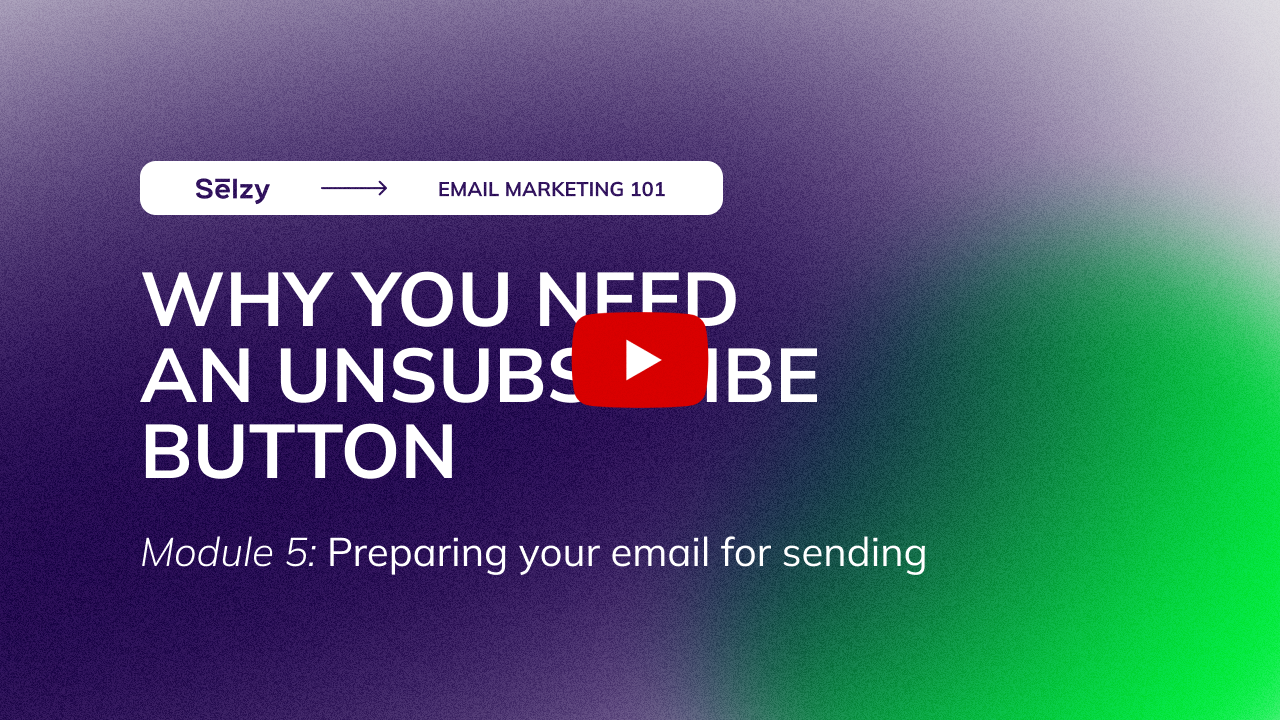Why You Need Unsubscribe Button
This is a transcript of lesson 14 of Email Marketing 101 Course by Selzy.

Hello and welcome to Lesson 2. Let’s dive into the world of the unsubscribe button. In this lesson, we’re going to talk all about why it’s important, where to place it, and how to add it to your emails. So, get ready to become an expert!
If you have ever opted in an email list, you’ve probably seen links like these in the newsletters you receive:

This visual is only available in a video lesson
These opt-out links are vital for any marketing or media bulk email. Let’s find out why.
Reason #1: It is the law
Several laws require you to provide a clear way for people to opt-out of receiving your emails.
For example, the CAN-SPAM act stipulates that your message must include a clear and conspicuous explanation of how to opt out of getting your emails in the future.
The General Data Protection Regulation act requires that it should be as easy to withdraw from your emails as to give consent.
The takeaway is: if you don’t want legal issues, do the right thing and add an opt-out link.
Reason #2: It protects your email deliverability
Imagine that you don’t provide an easy way to opt out of your emails. At some point, your subscribers might get annoyed. They don’t want your emails anymore, start marking them as spam or even block your domains. The more reports you get, the worse your email domain reputation is. As a result, your email marketing platform starts “seeing” your emails as spam. The worse your domain reputation is, the fewer people receive your emails. It happens because your email marketing tool “learned” that your emails are not desirable and put them in spam folders.
But if you do add an unsubscribe button, your domain will get fewer spam complaints — and you’ll keep the bounce rate low.
Reason #3: It keeps your contact list healthy
A healthy contact list means that it has no invalid email addresses or inactive subscribers. Why is it important?
Spam reports are not the only red flag for email marketing platforms — low engagement is as well. Too many recipients ignore your emails, damaging your domain reputation. And, as you already know, a bad domain reputation means lower deliverability, worse campaign metrics, and less revenue from email marketing.
Adding an opt-out button means that your contact list will clean itself — at least partially. You still have to manually remove invalid addresses or subscribers who are fed up with your content but are too lazy to opt-out. However, an unsubscribe button will make it easier to keep your contact list full of genuinely interested customers ready to give you clicks.
Reason #4: It makes your brand more trustworthy
You’re acting intrusive if you don’t allow users to opt out of your marketing emails. Think of an annoying coworker who really wants to be friends with you, so they keep texting you on weekends. You ghost them, but they keep sending you dumb memes. And even when you block them, they create numerous new accounts on social media. That’s how customers perceive intrusive ads. But there’s more to it.
An unsubscribe link gives you an excellent opportunity to collect feedback. Add a survey to the unsubscribe page — ask your former subscribers why they opted out. It will show that you care about your customers and will help you decrease the number of unsubscribes in the future, because now you’ll be aware of the reason why the unsubscribes happen in the first place..
In the end, unsubscribe links are not just the law — it also shows you respect your customers.
Where you should put that unsubscribe link
Like other buttons in your email, an unsubscribe button is a CTA. But, although it’s mandatory, you obviously don’t want customers to click on it. Button placements can make or break your clicks. To some extent, it works like that for unsubscribe buttons as well. The most popular placement is the footer — like here:

This visual is only available in a video lesson
Why is that? Why can’t you put an unsubscribe link to the email body? Well, that’s because that means literally inviting customers to unsubscribe. You surely don’t have this intention. Save this space for all your “Shop now” incentives. That’s why many email marketing apps add the required link to the footer by default — including Selzy!
Now let’s find out how to add the unsubscribe link to your email.
How to add the unsubscribe link
In Selzy and other email marketing platforms, you can either use and customize the default unsubscribe link or add the link to the email body in the editor. Since it’s a link, all the HTML syntax rules are applicable to it.
Selzy has a separate in-built merge tag for unsubscribe links — {{UnsubscribeUrl}}. If you’re editing in HTML, simply add the tag instead of the URL as a value for the “href” variable. If you’re editing in the block text editor, use the Insert/Edit link button in the toolbar:
And just like that, we now have a perfect email ready to be sent.
Once you send the email and wait for a while, it’s time to analyze your campaign. But what do those numbers ACTUALLY mean? What should you really focus on and what you can simply disregard? Let’s get this sorted out in Module 6 where we’ll tell you about the most important email campaign metrics to keep an eye on!
This is a transcript of lesson 14 of Email Marketing 101 Course by Selzy.